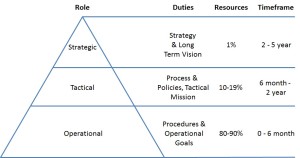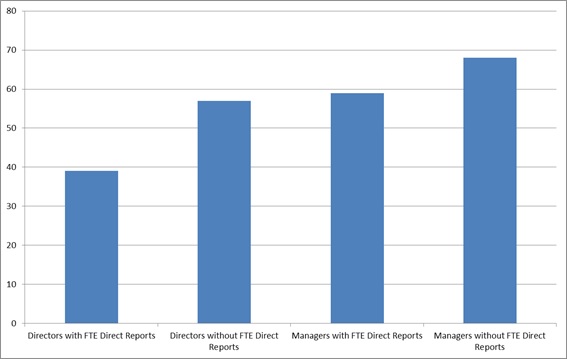 When discussing organizational management, a critical aspect is the balance between Strategic, Tactical, and Operational roles and duties.
When discussing organizational management, a critical aspect is the balance between Strategic, Tactical, and Operational roles and duties.
Have you ever seen companies where the employees complained that:
- The directors and upper level managers keep sticking their nose in the day-to-day operations and making a mess of things.
- Major processes keep getting re-defined and no one can keep up with the changes.
- No one takes time to review the documented procedures, and when they show the docs to a new hire, the docs are hopelessly out of date.
All these issues are symptoms of an organization’s failure to separate Strategic, Tactical, and Operational roles and duties.
First we should define what the terms Strategic, Tactical and Operational mean.
- Strategic – Long term thinking. Concerned with issues and decisions that will have 2+ year window of effect.
- Tactical – Medium term thinking. Focusing on issues that need attention within a 6 month to 2 year window.
- Operational – Day-to-day concerns.
Many people reverse the definition for Strategic and Tactical, but I like to remember the time I was training an ITIL class at a government organization. After discussing the ideas of Strategic and Tactical roles, one of the students raised his hand and said “I have no problem remembering the order of those two terms. I was previously in the Air Force and we had similar terms, but to me they meant: Tactical – Under 10 megatons, Strategic – Anything over 10 megatons.”
| Role | Duties | Timeframe | Title | % of Org |
| Strategic | Define long term goals, direction, and strategy. This is what book one of the ITIL v3 Library is focused on. | 2+ years out with an event horizon of about 5 years. | CIO, CEO, CFO, etc. | 1% |
| Tactical | Define the policies and processes that support the organizations long term strategy | 6 months to 2 years | Senior Director, Director, Senior Manager | 10-19% |
| Operational | Day-to-day execution of policies and processes, typically documented in procedures | Immediate, ever changing. What you did yesterday can change from what you will be doing tomorrow | Line Managers and everyone else | 80-90% |
Some of the most disruptive events occur because Directors and Managers (who should be operating at the Tactical level) keep making process and policy changes at an Operational interval. A good example of this would be changing your organization’s Change Management ticketing system more frequently than every 2 years. The fact that the Change process is controlled by a vendor’s ticketing system makes the required organizational change overwhelming.
Here is a good example of the different roles and responsibilities at each level:
- Strategic – We will have a HIPPA compliant Change Management system implemented by 2016. The reports will be used to prove compliance with HIPPA regulations. Failure to comply with the new Change Management system will result in HR violations and potential firing.
- Tactical – We will develop holistic Change Management process and policies, create a project plan to implement them, and a training plan for the appropriate employees by June of 2015.
- Operational – We will write the step-by-step procedures and ensure that the procedures are maintained. We will perform bi-annual training sessions for new hires or whenever there significant procedural changes. We will then execute the day-to-day procedures defined in the process.
Another concern is that you must balance the organization’s talent pool amongst these three areas trying to match the 80/20 ratio (90/10 is even better) of non-management to management.
I have seen companies who assumed everything would be better if you just had enough management. Here is a graph I generated from Active Directory (it is amazing the information you can pull out of AD) from a company that had more Directors/Managers with no direct reports than Directors/Managers who did have direct reports:
This imbalance was also reflected in the ratio of employees with a Director or Manager title to employees without a Director or Manager title:
As you can see, almost 35% of the employees were either Tactical or Strategic. To say that this company had management difficulties would be an understatement.
The lessons to learn are:
- Make sure there is a strategic vision in place that the processes and policies can be designed to support.
- Don’t change policies or process more frequently than every 2 years.
- Tune your operational procedures as frequently as you need to, but be sure that your supporting documentation is also updated.
- Make sure you balance your roles appropriately.



Leave a Reply